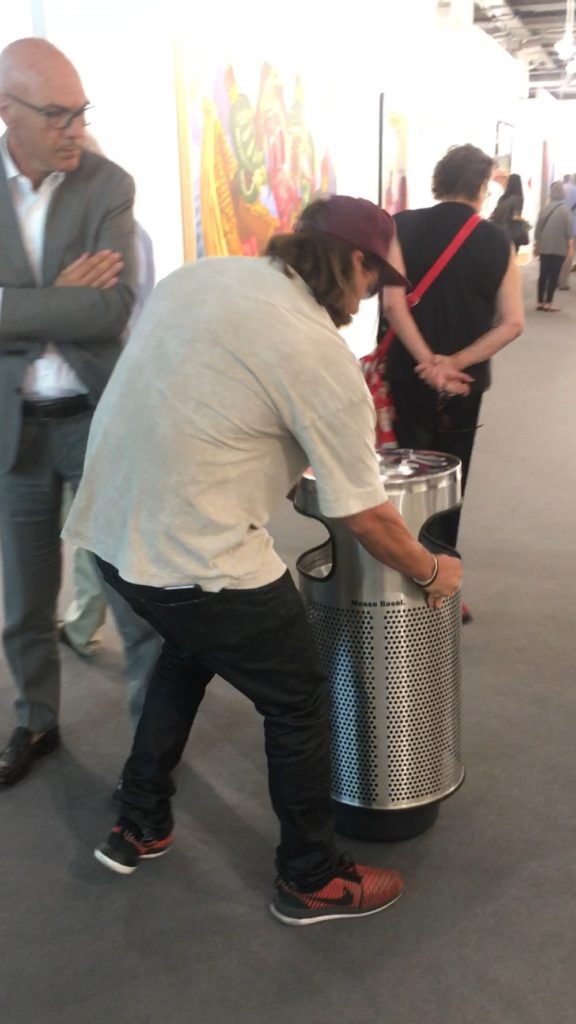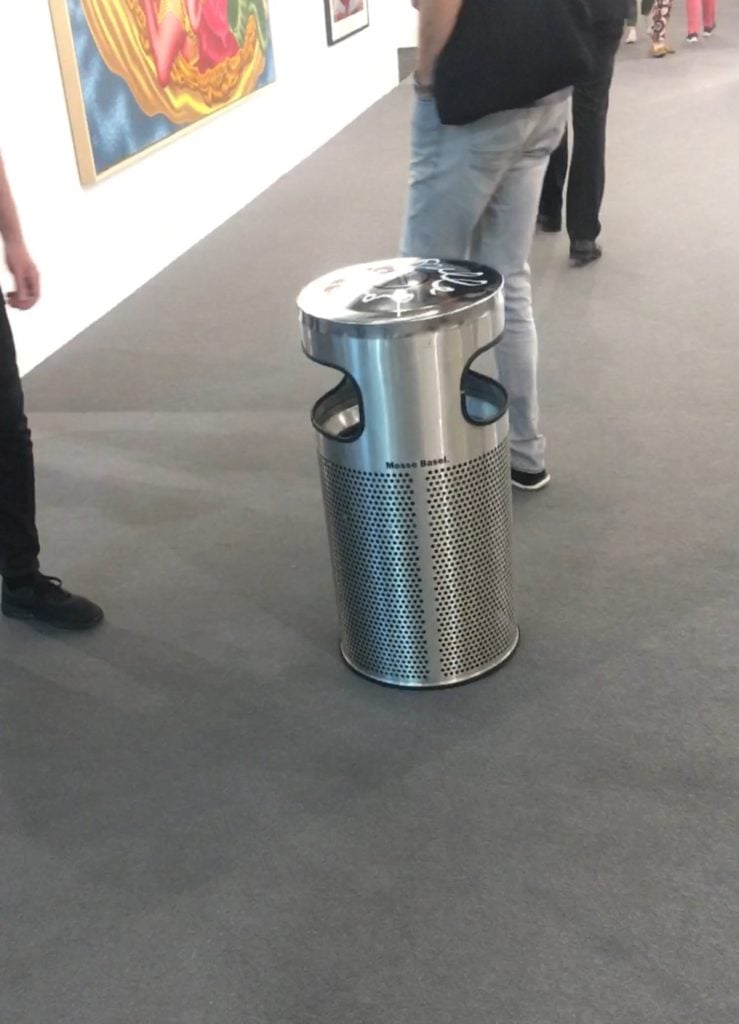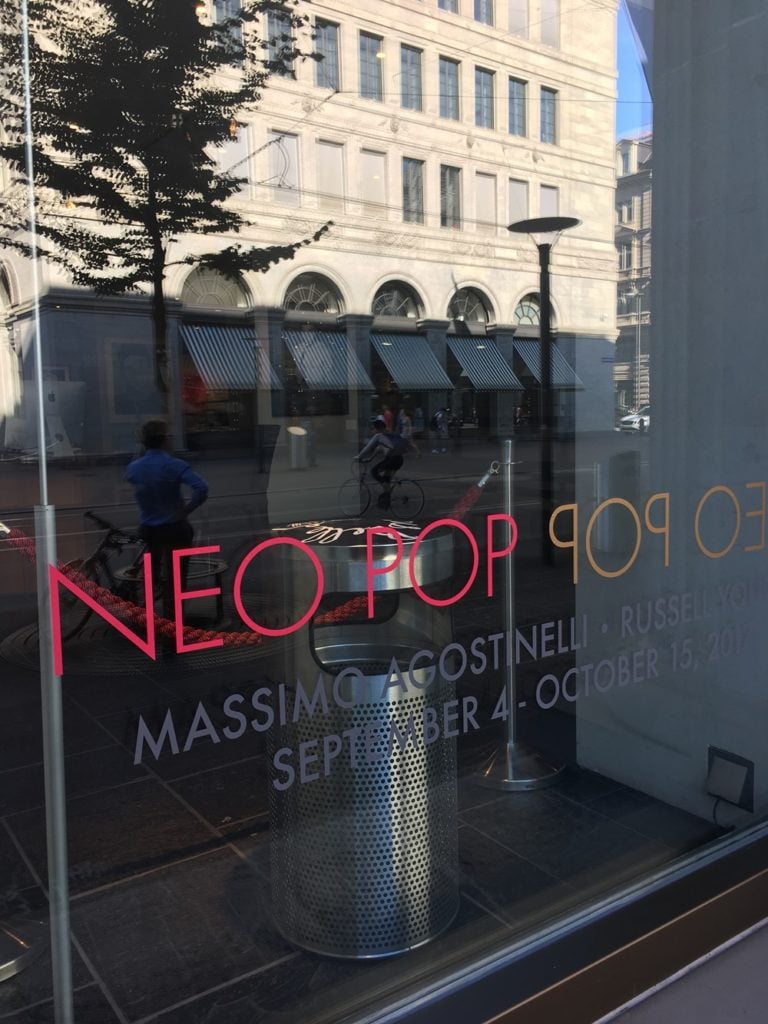People
How a Roguish Artist Set Out to Prank the Art World With an Art Basel Trash Can—and a Little Help From the Nahmads
Some are calling it "one of the most engaging works made in 2017."

Some are calling it "one of the most engaging works made in 2017."

Eileen Kinsella

The sheer diversity of wares on view at any contemporary fair is enough to make even the most seasoned art lover wonder, “What is art?” That, indeed, was just what was on the mind of young artist Massimo Agostinelli this past June, as he wandered the halls of Art Basel in Switzerland, locked in intense discussion about the state of art today with David and Joseph Nahmad, the famed father-and-son art dealers.
Then inspiration struck.

Massimo Agostinelli installing the trash can. Courtesy Massimo Agostinelli
Agostinelli grabbed one of the dozens of identical perforated steel trash bins placed throughout the fair, all of which bear the label “Messe Basel” (the convention center where the fair takes place). He whipped out a handy marker, and scrawled “la plus belle” across the top of the bin, a French phrase that translates to “the most beautiful” in English.
“It’s a play on words from its true meaning and definition ‘La Poubelle’ in French which means ‘Garbage Bin’ in English,” Agostinelli explained by phone to artnet News recently, recounting the stunt. “So just by slightly altering a few letters, the meaning has radically and drastically changed!”
Having thus transformed the common trash receptacle into a work of site-specific conceptual art, Agostinelli placed it in the center of the lane adjacent to the booths of mega-galleries Hauser & Wirth and White Cube. He then stood back and watched as fairgoers wandered by and gawked, some clearly assuming, he said, that it was a fair-sanctioned pop-up art installation.
It wasn’t until hours later that Messe Basel maintenance staff noticed the misplaced, marked-up bin, and carted it away.

Massimo Agostinelli inspecting his impromptu work at Art Basel. Courtesy Massimo Agostinelli
The gesture was a hit—at least with Agostinelli’s companions.
In an email later to artnet News, Joseph Nahmad confirmed the account and expressed high praise for the intervention. “I found this highly comical and smart as it questions the norm of what art is, how it can be made, and how it’s perceived by members of the public,” the dealer commented. “Definitely one of the most engaging works made in 2017 at the fair.”

Massimo Agostinelli’s impromptu work at Art Basel. Courtesy Massimo Agostinelli
Art Basel, in general, is distinguished among art fairs for its taste and decorum. Were the organizers of the esteemed fair upset at the playful prank?
On the contrary, says Agostinelli. In fact, they were happy to get in on the joke, or at least to get a piece of the action.
With the Nahmads’ help, Agostinelli arranged to buy the garbage bin from the organizers as a memento—for the very reasonable sum of €100 (about $120), which would be a true bargain for a work at Art Basel. A member of the maintenance staff even helped Agostinelli cart his new acquisition away.
Now the bin has made the full transition from trash bin to objet d’art. Vertes Gallery, which represents Agostinelli in Zurich, currently has the newly minted readymade sculpture on display as part of a group show titled “NEO POP POP NEO.”
What began as a spur-of-the-moment joke is getting more and more serious all the time. The artist told artnet News that he is reworking the bin into sculptural versions made of marble, wood, glass, bronze, and gold.

The bin on display at Vertes Gallery in Zurich. Courtesy Massimo Agonstinelli
Of course, the notion of art made from rubbish is not entirely new, nor is the public’s confusion over whether it is, in fact, art. To take just one example, at London’s Eyestorm Gallery in 2001, a diligent janitor cleared away a pile of beer bottles, ashtrays, coffee cups, and other detritus—failing to recognize it as a sculptural installation by Damien Hirst commenting on his own lifestyle.
Still closer in spirit to Agostinelli’s on-the-fly act of institutional critique was a prank by two California teenagers last spring, who placed a pair of eyeglasses on the floor of the San Francisco Museum of Modern Art, then watched as visitors mistook it for art. The SFMOMA glasses attracted so much interest that the stunt made the pages of the New York Times.
Still, Agostinelli, who is the son of billionaire financier Robert Agostinelli, may have broken new ground by literally buying his own joke.